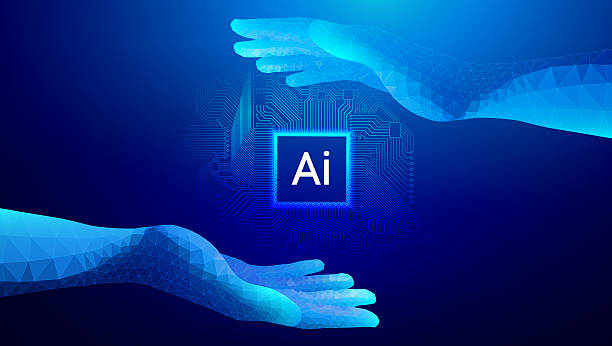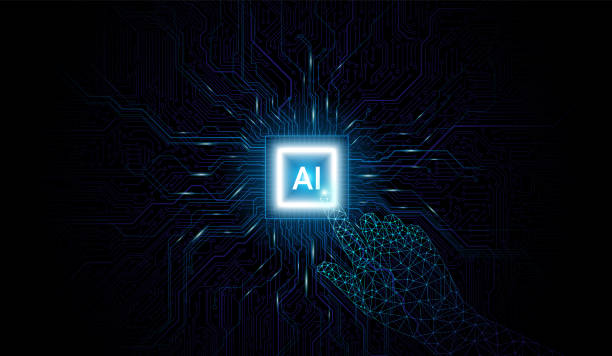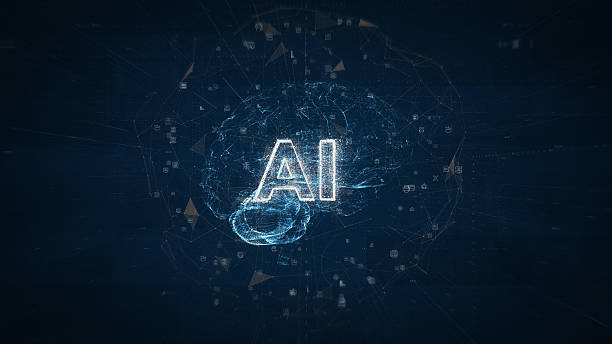What is Artificial Intelligence and How Does it Work?
#Artificial_Intelligence (#AI) is a branch of computer science that seeks to create machines that can perform tasks that typically require human intelligence.
This includes learning, problem-solving, pattern recognition, and natural language understanding.
Artificial Intelligence attempts to mimic human cognitive processes using complex algorithms and mathematical models.
The basis of artificial intelligence is collecting and analyzing data.
This data can be collected from various sources such as text, images, audio, and video.
Then, machine learning algorithms are applied to this data to discover patterns and hidden relationships within it.
These patterns and relationships allow the machine to make decisions, make predictions, and answer questions.
Deep Learning is an important sub-branch of machine learning that uses artificial neural networks with multiple layers to analyze complex data.
In short, artificial intelligence tries to enable machines to think, learn, and act like humans.
This technology has widespread applications in various industries, including healthcare, manufacturing, transportation, and financial services.
Artificial Intelligence is rapidly advancing and has the potential to change many aspects of our lives.
Important applications include self-driving cars, virtual assistants, and facial recognition systems.
The development of artificial intelligence requires continuous research and development in various fields, including algorithms, data, and hardware.
Research shows that 80% of customers trust companies with professional websites more. Does your current website inspire this confidence?
With Rasaweb’s corporate website design services, solve the problem of customer distrust and a weak online image forever!
✅ Create a professional image and increase customer trust
✅ Attract more sales leads and grow your business
⚡ Get a free consultation
Types of Artificial Intelligence and Their Applications
Artificial intelligence can be divided into several categories based on their abilities and capabilities.
One common classification is based on “ability,” which includes Narrow AI, General AI, and Super AI.
Narrow AI, which we see more of today, is designed to perform a specific task and specializes in that area.
For example, facial recognition systems or recommendation algorithms on social networks are in this category.
General AI, which has not yet been fully realized, has the ability to do anything that a human can do.
Finally, Super AI surpasses human intelligence and can solve more complex problems.
In terms of application, artificial intelligence is used in various fields.
In healthcare, artificial intelligence can help diagnose diseases, develop drugs, and provide personalized care.
In the manufacturing industry, artificial intelligence is used to automate processes, improve product quality, and reduce costs.
In the financial field, artificial intelligence can help detect fraud, manage risk, and provide personalized financial services.
Also, in transportation, artificial intelligence plays a role in the development of self-driving cars and route optimization.
One of the attractive applications of artificial intelligence is in the field of education and learning.
AI-based educational systems can help provide personalized education, assess student performance, and provide timely feedback.
These systems can help students learn at their own pace and in their own way, and develop their talents in the best possible way.
Machine Learning and Its Role in the Development of Artificial Intelligence
Machine Learning is one of the main sub-branches of artificial intelligence that allows machines to learn from data without explicit programming.
This process involves using algorithms to analyze data, identify patterns, and build models that can be used for prediction or decision-making.
Machine learning is widely used in various applications, including image recognition, natural language processing, and recommendation systems.
There are different types of machine learning algorithms, including Supervised Learning, Unsupervised Learning, and Reinforcement Learning.
In supervised learning, the model is trained using labeled data, meaning that each input data is accompanied by a desired output.
In unsupervised learning, the model is trained using unlabeled data and must discover patterns and structures on its own.
In reinforcement learning, the model is trained by interacting with an environment and receiving feedback in the form of reward or punishment.
Deep Learning is one of the most advanced methods of machine learning that uses artificial neural networks with multiple layers to analyze complex data.
Deep neural networks are capable of learning complex and abstract patterns in data and have achieved remarkable results in areas such as image recognition, natural language processing, and speech recognition.
For example, facial recognition and machine translation systems based on deep learning have been able to provide much better performance than traditional methods.
In the table below, we compare the three main types of machine learning:
| Learning Type | Description | Applications |
|---|---|---|
| Supervised Learning | Training the model using labeled data | Image recognition, stock price prediction |
| Unsupervised Learning | Training the model using unlabeled data | Customer clustering, anomaly detection |
| Reinforcement Learning | Training the model by interacting with the environment and receiving feedback | Computer games, robotics |
Challenges and Limitations of Artificial Intelligence
Despite the remarkable advances in artificial intelligence, there are still significant challenges and limitations.
One of the main challenges is the lack of sufficient and high-quality data to train artificial intelligence models.
Many machine learning algorithms require a large amount of data to be able to learn complex patterns and perform well.
In addition, collecting and labeling data can be time-consuming and costly.
Click here to preview your posts with PRO themes ››
Another challenge is the issue of Interpretability of artificial intelligence models.
Many deep learning models, especially deep neural networks, are known as “black boxes,” meaning that it is difficult to understand how a model arrived at a particular result.
This issue can create problems in fields such as healthcare and law, because in these fields, explaining the reason for a decision is very important.
In addition, the issue of Bias in data and algorithms is also a serious challenge.
If the training data is biased, artificial intelligence models will also learn this bias and may make unfair or discriminatory decisions.
For example, facial recognition systems may perform worse in recognizing the faces of people with darker skin tones if the training data does not include enough of these people.
Ethical and social issues are also among the important challenges of artificial intelligence.
The use of artificial intelligence in areas such as autonomous weapons and surveillance systems can have serious consequences for human rights and security.
Therefore, the development and use of artificial intelligence must be done with consideration of ethical and social issues, and appropriate laws and regulations must be put in place.
Are you tired of your online store having visitors but no sales? Rasaweb solves your core problem by designing professional online stores!
✅ Significant increase in sales with targeted design
✅ Flawless user experience for your customers
⚡ Get free advice!
The Future of Artificial Intelligence and Its Impact on Our Lives
The future of artificial intelligence is very bright and full of potential.
With continuous advances in algorithms, data, and hardware, artificial intelligence is expected to play a more important role in our lives in the coming years.
One of the important trends is the development of Artificial General Intelligence (AGI), which allows machines to do anything that a human can do.
Although there is still a long way to go to achieve AGI, research and progress in this area continue.
Another important trend is the development of Explainable AI, which seeks to create artificial intelligence models that can explain the reason for their decisions.
This can help increase trust and acceptance of artificial intelligence in various fields.
In addition, artificial intelligence is expected to create fundamental changes in areas such as healthcare, education, and transportation.
For example, artificial intelligence can help with early diagnosis of diseases, provide personalized education, and develop self-driving cars.
However, the development of artificial intelligence also comes with challenges and risks.
One of the concerns is the impact of artificial intelligence on the labor market.
Automation of processes and replacement of human labor by machines can lead to job losses and increased economic inequality.
Therefore, it is necessary to develop policies and programs to manage these changes and support affected workers.
Also, the ethical and social issues of artificial intelligence must be seriously considered, and appropriate laws and regulations must be put in place.
The Role of Data in Artificial Intelligence
Data is the fuel of artificial intelligence.
Without sufficient and high-quality data, artificial intelligence models cannot be properly trained and perform well.
Data can be collected from various sources such as sensors, mobile devices, social networks, and databases.
The volume, speed, and variety of data in today’s world have increased dramatically, and this has created new opportunities for the development of artificial intelligence.
Data Preparation is one of the important steps in the artificial intelligence development process.
This step includes cleaning data, transforming data, and reducing data dimensions.
Cleaning data means removing or correcting incorrect, incomplete, or inconsistent data.
Transforming data means converting data into a format that can be used for machine learning algorithms.
Reducing data dimensions means reducing the number of features in the data to reduce the complexity of the models and improve their performance.
In addition to data preparation, the issue of data privacy is also very important.
The collection and use of personal data must be done in compliance with applicable laws and regulations, and the privacy of individuals must be protected.
The use of techniques such as data anonymization and data encryption can help protect data privacy.
Also, the issue of access to data is very important for the development of artificial intelligence.
Many companies and organizations have a large amount of data that can be used for the development of artificial intelligence.
However, access to this data may be limited due to legal, commercial, or technical issues.
Creating appropriate platforms for data sharing and cooperation between organizations can help accelerate the development of artificial intelligence.
Tools for Artificial Intelligence Development
The development of artificial intelligence requires specific software tools and frameworks.
Fortunately, today there are many open-source and commercial tools and frameworks available to developers that can help them in the artificial intelligence development process.
One of the most popular open-source frameworks is TensorFlow, which was developed by Google.
TensorFlow is a powerful library for machine learning that supports various programming languages, including Python and C++.
Click here to preview your posts with PRO themes ››
Another open-source framework is PyTorch, which was developed by Facebook.
PyTorch is also a powerful library for machine learning that has attracted the attention of many developers due to its flexibility and ease of use.
In addition, other libraries such as Scikit-learn and Keras are also available for machine learning, which can help developers build artificial intelligence models.
In addition to software frameworks, other tools are also used for artificial intelligence development.
Integrated Development Environments (IDEs) such as PyCharm and VS Code can help developers write, test, and debug code.
Data management tools such as Apache Spark and Hadoop can help process and analyze large amounts of data.
And model deployment tools such as Docker and Kubernetes can help deploy artificial intelligence models in different environments.
In the table below, we compare TensorFlow and PyTorch:
| Feature | TensorFlow | PyTorch |
|---|---|---|
| Developer | ||
| Programming Language | Python, C++ | Python |
| Flexibility | Medium | High |
| Ease of Use | Medium | High |
Novel Research Areas in Artificial Intelligence
Artificial intelligence is an active and dynamic research field that is constantly evolving and advancing.
One of the novel research areas is Deep Reinforcement Learning, which is a combination of reinforcement learning and deep learning.
This method allows machines to learn complex strategies by interacting with an environment and receiving feedback.
Deep reinforcement learning has achieved remarkable results in areas such as computer games, robotics, and resource management.
Another research area is Natural Language Processing, which seeks to create machines that can understand and generate human language.
Natural language processing has made significant progress in areas such as machine translation, text summarization, and question answering.
However, there are still many challenges in this area, including understanding the meaning of text, recognizing emotions, and generating fluent and natural text.
Another research area is Computer Vision, which seeks to create machines that can understand images and videos.
Computer vision has made significant progress in areas such as facial recognition, object recognition, and medical image analysis.
However, there are still many challenges in this area, including understanding complex scenes, recognizing objects in poor lighting conditions, and generating realistic images.
In addition, other research areas such as artificial intelligence ethics, artificial intelligence security, and explainable artificial intelligence are also being developed.
These areas seek to solve the ethical, security, and social challenges associated with the development and use of artificial intelligence.
Tired of losing customers due to poor online store design? With Rasaweb, solve this problem forever!
✅ Increase sales and conversion rate from visitor to customer
✅ Smooth and attractive user experience for your customers⚡ Get free advice
Artificial Intelligence in Iran: Prospects and Opportunities
Artificial intelligence in Iran has also been considered as a strategic technology, and efforts have been made to develop and expand it in various fields.
The Iranian government has developed plans to support research and development in the field of artificial intelligence and the training of specialized human resources in this field.
Universities and research centers are also carrying out extensive activities in the field of artificial intelligence and implementing various projects in this field.
One of the important opportunities for artificial intelligence in Iran is its use in solving existing problems and challenges in the country.
Artificial intelligence can play an important role in areas such as water resource management, improving the quality of education, developing sustainable agriculture, and improving the health of society.
Also, artificial intelligence can help develop various industries, including the oil and gas industry, the automotive industry, and the information technology industry.
Another important opportunity for artificial intelligence in Iran is the development of exports of products and services based on artificial intelligence.
Iran has specialized and talented human resources in the field of information technology and artificial intelligence and can have a share in the global artificial intelligence market by developing innovative products and services.
However, the development of artificial intelligence in Iran also faces challenges.
Lack of investment, limited access to advanced technologies, and lack of appropriate infrastructure are among these challenges.
To overcome these challenges, it is necessary for the government, the private sector, and universities to work together and develop and implement comprehensive plans for the development of artificial intelligence in the country.
Given the high potential of artificial intelligence for economic and social development of the country, investment in this area can have a very good return and help Iran’s growth and progress.
How to Learn Artificial Intelligence?
Learning artificial intelligence can be an exciting and rewarding journey.
To start, you can familiarize yourself with the basic concepts of artificial intelligence and machine learning.
There are many online resources such as online courses, blogs, and books that can help you with this.
Online courses on platforms such as Coursera, edX, and Udacity can be a good start.
Click here to preview your posts with PRO themes ››
After familiarizing yourself with the basic concepts, you can start learning the programming languages used in artificial intelligence.
Python is one of the most popular programming languages for artificial intelligence, and there are powerful libraries such as TensorFlow and PyTorch for machine learning in Python.
Learning Python and using these libraries can help you build artificial intelligence models.
In addition to learning programming languages and libraries, you can strengthen your skills in the field of artificial intelligence by participating in practical projects and working on real problems.
Participating in artificial intelligence competitions and collaborating with other developers can also help you learn and progress.
Also, it is important to continuously keep your knowledge in the field of artificial intelligence up to date.
Artificial intelligence is an evolving field, and new algorithms, methods, and tools are constantly being developed in this field.
Studying scientific articles, attending conferences, and following blogs and social networks related to artificial intelligence can help you keep your knowledge up to date.
Finally, patience and perseverance are the keys to success in learning artificial intelligence.
Learning artificial intelligence takes time and effort, but with practice and perseverance, you can become an expert in this field.
Frequently Asked Questions
| Question | Answer |
|---|---|
| 1. What is Artificial Intelligence (AI)? | It is a branch of computer science that aims to create machines capable of simulating human intelligence and performing tasks that require human thinking, such as learning, problem-solving, and decision-making. |
| 2. What are the main types of artificial intelligence? | It can be classified into Weak Artificial Intelligence (Narrow AI) that focuses on a specific task, General Artificial Intelligence (General AI) that possesses comprehensive human capabilities, and Super Artificial Intelligence (Super AI) that exceeds human intelligence. |
| 3. Mention some common applications of artificial intelligence in our daily lives. | Includes voice assistants (such as Siri and Alexa), recommendation systems (such as Netflix and Amazon), self-driving cars, facial recognition systems, and spam filters. |
| 4. What is the difference between Artificial Intelligence and Machine Learning? | Artificial intelligence is the broader concept of creating intelligent machines, while machine learning is a subset of artificial intelligence that focuses on enabling systems to learn from data without explicit programming. |
| 5. What is Deep Learning? | It is a subset of machine learning that uses multi-layered artificial neural networks (deep neural networks) to process data and discover complex patterns, and is used in image and speech recognition. |
| 6. What are the most prominent benefits of artificial intelligence? | Improving efficiency and productivity, automating repetitive tasks, making better decisions based on big data analysis, and developing solutions to complex problems in fields such as medicine and science. |
| 7. What are the main challenges facing the development and deployment of artificial intelligence? | Includes the need for vast amounts of high-quality data, privacy and security issues, bias in data and algorithms, and high development and maintenance costs. |
| 8. Does artificial intelligence raise ethical or social concerns? | Yes, it raises concerns about privacy, algorithmic bias, job losses due to automation, responsibility for errors committed by intelligent systems, and the need for a regulatory framework. |
| 9. How can artificial intelligence affect the future of the labor market? | It can lead to the automation of some routine tasks, but it will also create new jobs that require advanced skills in developing, operating, and maintaining artificial intelligence systems. |
| 10. What are some modern or promising technologies in the field of artificial intelligence? | Includes advanced Natural Language Processing (NLP) (such as large language models like ChatGPT), computer vision, robotics, and Generative AI. |
And other services of Rasa Web Advertising Agency in the field of advertising
Smart Brand Identity: Professional optimization for customer behavior analysis using a SEO-based content strategy.
Smart UI/UX: A creative platform to improve SEO ranking by customizing the user experience.
Smart Google Ads: Transform online growth with the help of a SEO-based content strategy.
Smart Direct Marketing: A combination of creativity and technology for campaign management by optimizing key pages.
Smart Marketplace: A creative platform to improve campaign management with smart data analysis.
And more than hundreds of other services in the field of internet advertising, advertising consulting and organizational solutions
Internet advertising | Advertising strategy | Advertorial
Resources
What is Artificial Intelligence (AI)? Let’s know its applications and future
,What is Artificial Intelligence? | Applications, types, advantages and disadvantages of it
,What is artificial intelligence and what are its applications? (+ types and levels of it)
,What is artificial intelligence? How does it work and why is it important?
? With “Rasawb Afrin”, your business takes off in the digital world! From fast website design and creativity to comprehensive online marketing strategies, we are your digital success partner.
📍 Tehran, Mirdamad Street, next to the Central Bank, South Kazerun Alley, Ramin Alley No. 6













